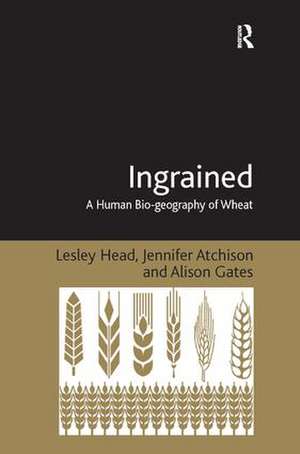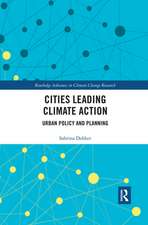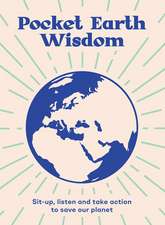Ingrained: A Human Bio-geography of Wheat
Autor Lesley Head, Jennifer Atchisonen Limba Engleză Hardback – 28 aug 2012
| Toate formatele și edițiile | Preț | Express |
|---|---|---|
| Paperback (1) | 469.64 lei 6-8 săpt. | |
| Taylor & Francis – 15 noi 2016 | 469.64 lei 6-8 săpt. | |
| Hardback (1) | 1113.91 lei 6-8 săpt. | |
| Taylor & Francis – 28 aug 2012 | 1113.91 lei 6-8 săpt. |
Preț: 1113.91 lei
Preț vechi: 1358.43 lei
-18% Nou
Puncte Express: 1671
Preț estimativ în valută:
213.18€ • 221.73$ • 175.99£
213.18€ • 221.73$ • 175.99£
Carte tipărită la comandă
Livrare economică 15-29 aprilie
Preluare comenzi: 021 569.72.76
Specificații
ISBN-13: 9781409437871
ISBN-10: 1409437876
Pagini: 246
Ilustrații: Includes 46 b&w illustrations
Dimensiuni: 156 x 234 x 16 mm
Greutate: 0.59 kg
Ediția:New ed
Editura: Taylor & Francis
Colecția Routledge
Locul publicării:Oxford, United Kingdom
ISBN-10: 1409437876
Pagini: 246
Ilustrații: Includes 46 b&w illustrations
Dimensiuni: 156 x 234 x 16 mm
Greutate: 0.59 kg
Ediția:New ed
Editura: Taylor & Francis
Colecția Routledge
Locul publicării:Oxford, United Kingdom
Notă biografică
Professor Lesley Head is an ARC Australian Laureate Fellow and Director of the Australian Centre for Cultural Environmental Research (AUSCCER) at the University of Wollongong, Australia, Dr Jennifer Atchison, (AUSCCER) is at the University of Wollongong, Australia and Dr Alison Gates (AUSCCER) is at the University of Wollongong, Australia
Recenzii
'Where does a crop leave off and the rest of the world begin? Head, Atchison and Gates answer this difficult question by confronting not only what it is to be a plant but also what it is to be human. More than a book about Triticum, Ingrained compellingly asks us to reconsider how we think about ourselves, global commodities, plant breeding, co-evolution and breakfast.' Paul Robbins, author of Lawn People: How Grasses, Weeds and Chemicals Make Us Who We Are 'Engagingly written and theorised, this book tracks the networks through which grass turned to "wheat" to become ingrained in a bumper crop of commodities and technologies from the molecular to the multinational. The ghostly flora of wheat - in all its own plantiness - comes alive in the intimately entangled geographies of humans and nonhumans. Ingrained is a delight to digest.' Kay Anderson, University of Western Sydney, Australia '... no matter what sort of geographer you are, you will get something, including an enjoyable read, from this book.' Geographical Research '[The authors] provide a book which is engagingly written and theorised, of a high academic standard, and a common subject approached in a non-conformist way. Moreover, the book emphasises the cultural dimension of the environmental debate, a factor that is often given insufficient attention. This publication appeals to an audience searching for new ways of interdisciplinary thinking, as it integrates rural, urban and industrial frontiers, and offers both local and global perspectives.' International Journal of Environment and Pollution 'Overall, the book lies somewhere between a highly educational text and an intriguing work of non-fiction. It provides a fascinating insight into the manner in which wheat is integrated into our everyday lives. It is recommended to any member of the public with an interest in the role of wheat in society, and how it got there, as well as to the many industry professionals that would benefit from a broader knowle
Cuprins
Chapter 1 Ingrained; Chapter 2 Reapproaching Human-Plant Geographies; Chapter 3 Becoming Wheat; Chapter 4 Spaces of Wheat; Chapter 5 Growing Wheat; Chapter 6 Mobility, Friction and Fungibility; Chapter 7 Wheat Becomes Quality Food; Chapter 8 Transformation; Chapter 9 Wheat Futures; Chapter 10 Conclusion;
Descriere
Theoretically, this book develops new insights by bringing together human geography, biogeography and archaeology to provide a long term perspective on human-wheat relations. Although the relational, more-than-human turn in the social sciences has seen a number of plant-related studies, these have not yet fully engaged with the question of what it means to be a plant. The book draws on diverse literatures to tackle this question, advancing thinking about how plants act in their worlds, and how we can better understand our shared worlds.
















